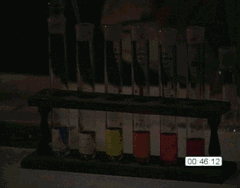Chemiluminescence
The process of chemiluminescence occurs when energy in the form of light is released from matter during a chemical reaction. This happens at low temperatures (<500°C) hence its more common term of “cold light”. Examples of chemiluminescence include the blue cone seen in a Bunsen burner flame and the very popular light sticks.
Examples of chemiluminescence reactions
http://www.chem.leeds.ac.uk/delights/video_photos/CHEM321.JPG
Light sticks provide illumination for a short period of time – normally a few hours – by mixing a chemiluminescent compound with an oxidant such as hydrogen peroxide in a breakable glass ampule (vial) inside the plastic tube. The colour of the light stick is determined by the fluorescent dye used in the mixture, and this increases the light output by shifting the emitted radiation into the visible range.
Chemiluminescent reactions are exothermic as they release energy. This energy is absorbed by a reaction product which produces an electronically excited state (denoted *). This rapidly decays to the ground state, emitting photons of visible light with energy equal to hν:
![]()
![]()
![]() A + B
C* + D
A + B
C* + D
![]() C* C + hν
C* C + hν
In light sticks the excited species transfers its electronic energy to the fluorescent dye (which is not involved in the reaction) thus emitting light of that colour.
 The
Chemiluminescent Rainbow Reaction http://www.chem.leeds.ac.uk/delights/animations/dnpo.html
The
Chemiluminescent Rainbow Reaction http://www.chem.leeds.ac.uk/delights/animations/dnpo.html